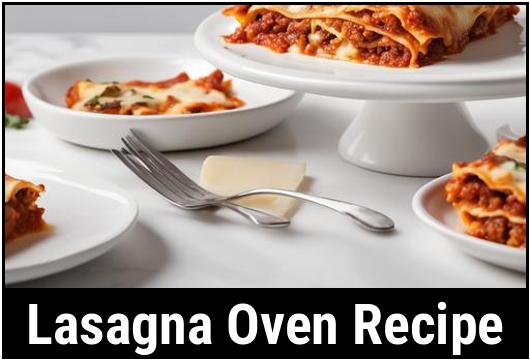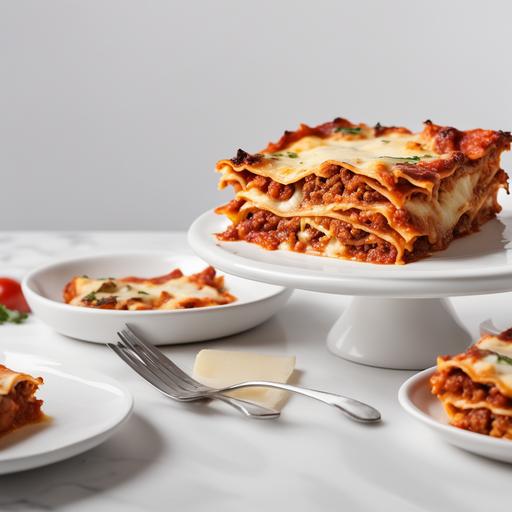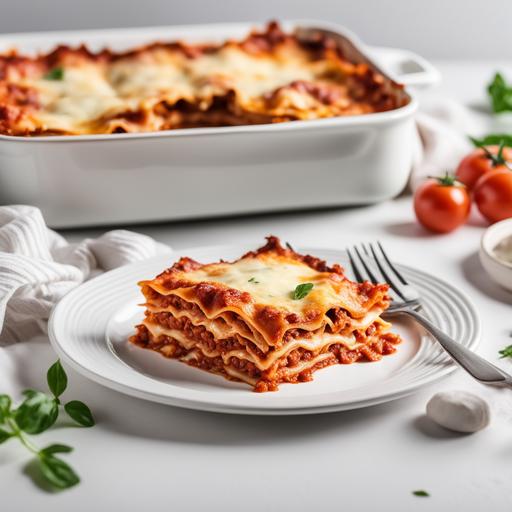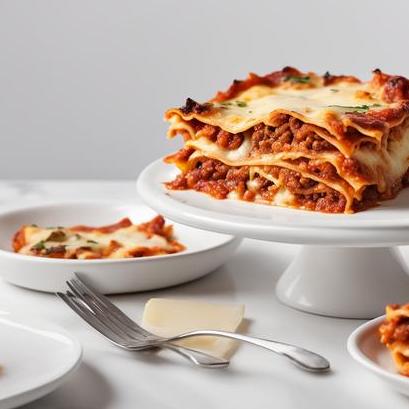
The Perfect Lasagna Oven Recipe: A Comprehensive Guide To Mouthwatering Perfection
If you’re a fan of hearty Italian cuisine, there’s nothing quite like a perfectly baked lasagna straight out of the oven. Layers of tender pasta, rich meat sauce, and creamy cheese come together in a symphony of flavors that is simply irresistible. In this comprehensive guide, we’ll delve into the world of lasagna, exploring the food science, culinary details, selection, cleaning, preparation, tips, variations, doneness checks, and more. So, roll up your sleeves and get ready to create a lasagna masterpiece that will leave your guests begging for more!
Understanding the Food Science behind Lasagna
Lasagna is not only a delicious comfort food; it also involves some food science principles that enhance its flavor and texture. Understanding these principles can help you achieve the perfect lasagna every time you fire up your oven.
The Role of Pasta
The foundation of any lasagna is its pasta sheets. To ensure an ideal texture, it’s crucial to cook the pasta sheets "al dente," which means they should still have a slightly firm bite. Overcooked pasta can turn mushy and compromise the integrity of the dish.
Meat Sauce Magic
The meat sauce, or "ragù," is another essential component of lasagna. Slow-cooking the meat, along with onions, garlic, tomatoes, and herbs, allows the flavors to meld together and create a robust, savory sauce. This process also tenderizes the meat, transforming it into succulent, fork-tender morsels that infuse each layer of your lasagna with incredible flavor.
The Cheese Factor
No lasagna is complete without copious amounts of cheese. Traditionally, a mix of mozzarella, Parmesan, and ricotta cheeses is used. Mozzarella provides a creamy, stringy texture, while Parmesan adds a nutty, salty kick. Ricotta cheese lends a velvety smoothness to the dish. Together, these cheeses create a symphony of flavors that elevate your lasagna to new heights.
Selecting and Cleaning Your Utensils
Before embarking on your lasagna-making adventure, it’s essential to ensure that your utensils and cookware are in top-notch condition.
Knife Skills
To achieve even, uniform slices of lasagna, a sharp knife is an absolute must. A chef’s knife or a serrated knife work best for this task. Ensure your knife is sharp and honed before getting started.
Casserole Dish Selection
The right casserole dish can make all the difference in how your lasagna turns out. Opt for a deep, rectangular dish that allows for layering without excessive spillage. A dish with high sides also helps maintain moisture and prevents your lasagna from drying out during baking.
Pristine Cookware
Lasagna typically involves simmering the meat sauce, so it’s vital to start with clean, well-seasoned cookware. Scrub away any residue, and ensure the pots and pans you use for cooking are free from burnt-on food. Stainless steel or cast-iron cookware are great options for making lasagna due to their excellent heat distribution.
Preparing the Ingredients and Tips for a Perfect Lasagna

Now that you’re equipped with the necessary knowledge and have your utensils ready, it’s time to dive into the actual preparation process. Below, we’ll guide you through the essential steps to achieve a perfect lasagna.
Ingredient Prep
-
Pasta Sheets: Use high-quality lasagna pasta sheets, either freshly made or store-bought. If using dry pasta, pre-cook it slightly under the recommended time to prevent overcooking during baking.
-
Meat Sauce: Select a combination of ground beef, pork, and veal for a well-rounded flavor. Brown the meat thoroughly, ensuring no pink remains. Drain off excess fat for a healthier lasagna.
-
Cheese Mix: Prepare a cheese mixture by combining shredded mozzarella, grated Parmesan, and creamy ricotta cheese. Season the ricotta with fresh herbs like basil and oregano for an extra burst of flavor.
-
Tomato Sauce: While there are endless variations, a classic tomato sauce is a great choice for lasagna. Combine crushed tomatoes, tomato paste, onions, garlic, and a medley of aromatic herbs like thyme and rosemary. Simmer the sauce to develop its flavors fully.
Tips for Layering
-
Start with a thin layer of tomato sauce on the bottom of your casserole dish. This prevents the bottom layer of pasta from sticking to the dish during baking.
-
Lay down a single layer of pasta sheets, slightly overlapping each other. This creates a cohesive base for your lasagna.
-
Spread a generous portion of meat sauce over the pasta layer, ensuring an even distribution. The texture and flavor of each bite depend on the distribution of sauce throughout the lasagna.
-
Dollop spoonfuls of the cheese mixture on top of the meat sauce. Use the back of a spoon or a spatula to spread it evenly, creating creamy pockets throughout the dish.
-
Repeat the layering process, ending with a final layer of pasta sheets, a drizzle of tomato sauce, and a generous sprinkle of the cheese mixture on top.
Doneness Checks
Determining when your lasagna is perfectly cooked requires a few visual cues:
-
The pasta sheets should be tender but firm, with no raw or overly chewy spots.
-
The cheese on top should be melted and slightly golden, providing an irresistible browned crust.
-
When you insert a knife into the center of the lasagna and remove it, there should be no resistance or excess liquid seeping out.
Variations and Creative Touches
Lasagna offers endless possibilities for customization. Here are a few variations and creative touches to jazz up your recipe:
-
Vegetarian Lasagna: Substitute the meat sauce with layers of roasted vegetables like zucchini, bell peppers, and eggplant. You can also add spinach, mushrooms, or any other veggies of your choice.
-
Seafood Lasagna: Replace the meat sauce with sautéd shrimp, scallops, or crabmeat. Complement these delicate flavors with a white sauce made from cream, butter, and Parmesan cheese.
-
Spinach and Three Cheese Lasagna: Incorporate layers of wilted spinach along with the classic cheese mixture for a vibrant and nutrient-rich twist.
Overcoming Common Challenges

Even seasoned chefs can stumble upon a few challenges while making lasagna. Don’t worry; here are some troubleshooting tips to overcome them:
1. Overcooked Lasagna
If you accidentally overcook your lasagna, resulting in dry and chewy pasta, there’s still hope:
-
Make a flavorful sauce, like a marinara or Bolognese, and spoon it over the dry lasagna. The sauce will permeate the pasta, adding much-needed moisture and reviving the flavors.
-
Drizzle some chicken or vegetable broth over the lasagna. Allow it to absorb for a few minutes before serving. This technique can salvage even the most overcooked lasagna.
2. Undercooked Lasagna
Should you find yourself with a partially undercooked lasagna, follow these tips to save the day:
-
Cover the dish with aluminum foil and return it to the oven. Bake for an additional 15-20 minutes at a slightly lower temperature to ensure the pasta cooks through without drying out the top layer.
-
Alternatively, you can slice the undercooked lasagna into individual portions and microwave them for a few minutes until fully cooked. This method saves time and can be a quick fix when you’re in a pinch.
Classic Lasagna Oven Recipe

Now that you have a solid understanding of the fundamentals let’s put everything together and create a classic lasagna masterpiece.
Ingredients:
-
1 pound (450g) lasagna pasta sheets
-
1 pound (450g) ground beef
-
1 pound (450g) ground pork
-
1 pound (450g) ground veal
-
1 large onion, finely chopped
-
4 cloves garlic, minced
-
2 cans (28 ounces each) crushed tomatoes
-
2 tablespoons tomato paste
-
2 teaspoons dried thyme
-
2 teaspoons dried rosemary
-
Salt and pepper, to taste
-
2 cups shredded mozzarella cheese
-
1 cup grated Parmesan cheese
-
2 cups ricotta cheese
-
Fresh basil and oregano for garnish
Instructions:
-
Preheat your oven to 375°F (190°C).
-
In a large, heavy-bottomed pot, cook the ground beef, pork, and veal over medium heat until browned. Ensure there is no pink remaining in the meat.
-
Drain off any excess fat from the meat and return it to the pot. Add the chopped onion and minced garlic, cooking until they become translucent and fragrant.
-
Pour in the crushed tomatoes and tomato paste, stirring to combine. Add the dried thyme, dried rosemary, salt, and pepper. Simmer the sauce for 30-45 minutes until the flavors meld together.
-
While the sauce simmers, cook the lasagna pasta sheets according to the package instructions, making sure they remain slightly undercooked. Drain and set aside.
-
In a mixing bowl, combine the shredded mozzarella, grated Parmesan, and ricotta cheese. Season with salt, pepper, fresh basil, and oregano. Mix well to form a creamy cheese mixture.
-
Spread a thin layer of tomato sauce on the bottom of your casserole dish to prevent sticking.
-
Place a layer of pasta sheets over the tomato sauce, overlapping slightly.
-
Spread a generous portion of the meat sauce over the pasta layer. Ensure an even distribution over the entire surface.
-
Dollop spoonfuls of the cheese mixture on top of the meat sauce, spreading it evenly to create a creamy layer.
-
Repeat the layering process, ending with a final layer of pasta sheets, a drizzle of tomato sauce, and a generous sprinkle of the cheese mixture on top.
-
Cover the dish with aluminum foil and bake for 30 minutes.
-
Remove the foil and bake for an additional 15-20 minutes until the lasagna is bubbly and the cheese on top turns golden brown.
-
Allow the lasagna to rest for 10-15 minutes before slicing. This allows the layers to set and ensures easy serving.
-
Garnish with fresh basil and oregano leaves before serving.
In Conclusion
Congratulations! You’ve successfully embarked on a lasagna-making journey that covers not only the recipe but also the science, tips, troubleshooting, and creative variations. Armed with this comprehensive guide, you now have the tools to create a mouthwatering lasagna that will entice the taste buds of all who have the pleasure of indulging. So, preheat that oven, gather your ingredients, and get ready to enjoy a truly satisfying and delicious lasagna feast!
Sources
FAQS On Lasagna Oven Recipe
What Ingredients Are Needed For A Classic Lasagna Oven Recipe?
To make a classic lasagna in the oven, you will need lasagna noodles, ground beef, diced tomatoes, tomato sauce, onion, garlic, mozzarella cheese, Parmesan cheese, ricotta cheese, eggs, and Italian seasoning.
How Do I Layer The Ingredients In A Lasagna Oven Recipe?
Start by spreading a layer of meat sauce on the bottom of a baking dish, then add a layer of lasagna noodles. Next, spread a layer of ricotta cheese mixture, followed by a layer of mozzarella cheese. Repeat these layers until you have used all of the ingredients, ending with a layer of mozzarella cheese on top.
How Long Should I Bake A Lasagna In The Oven?
Preheat your oven to 375°F and bake the lasagna, covered with foil, for 25 minutes. Then, remove the foil and continue baking for an additional 25-30 minutes, or until the cheese on top is golden and bubbly.
Can I Make A Vegetarian Lasagna Oven Recipe?
Yes, you can easily make a vegetarian lasagna by replacing the ground beef with vegetables such as mushrooms, zucchini, and spinach. You can also add extra layers of veggies, such as sliced bell peppers or eggplant, for a more hearty and nutritious dish.
Can I Prepare A Lasagna Oven Recipe Ahead Of Time?
Yes, you can assemble the lasagna ahead of time and refrigerate it for up to 24 hours before baking. This is a great option for busy weeknights or when hosting a dinner party, as the flavors will have time to meld together for an even more delicious dish.



